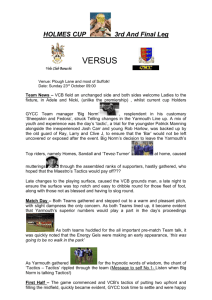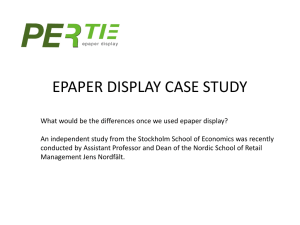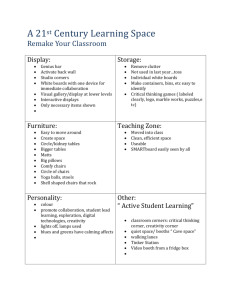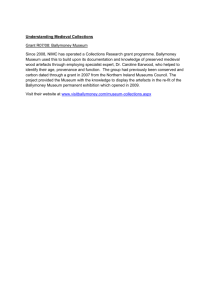The Seaside Holiday Displays at Time and Tide Museum
advertisement
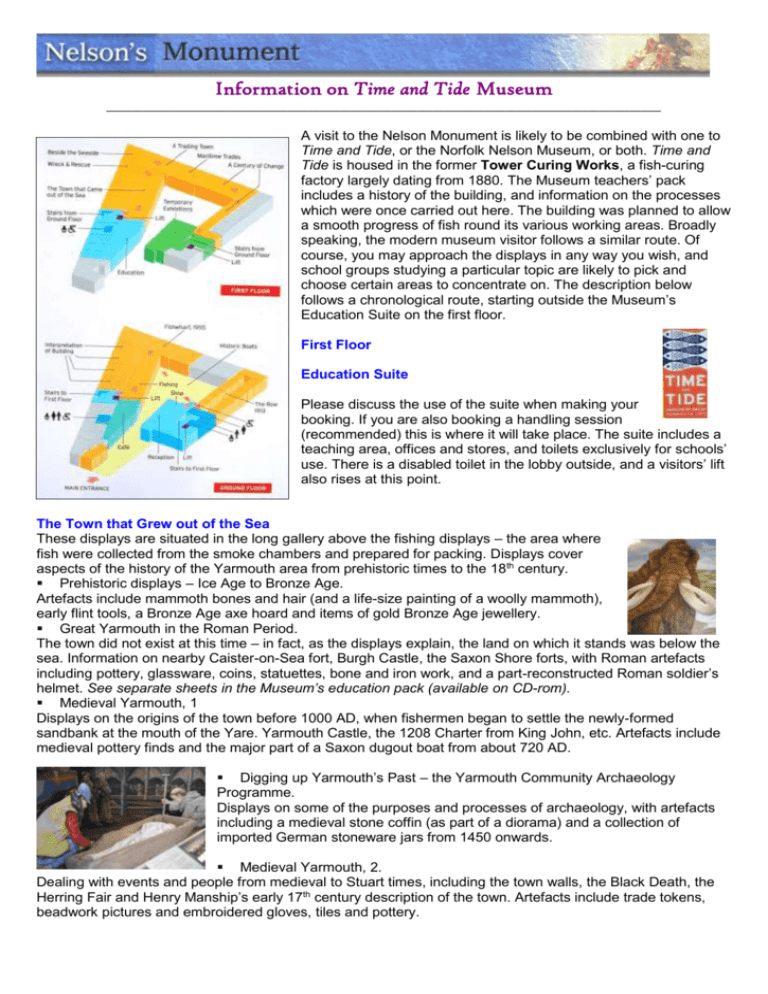
Information on Time and Tide Museum ___________________________________________________________________________________________________________ A visit to the Nelson Monument is likely to be combined with one to Time and Tide, or the Norfolk Nelson Museum, or both. Time and Tide is housed in the former Tower Curing Works, a fish-curing factory largely dating from 1880. The Museum teachers’ pack includes a history of the building, and information on the processes which were once carried out here. The building was planned to allow a smooth progress of fish round its various working areas. Broadly speaking, the modern museum visitor follows a similar route. Of course, you may approach the displays in any way you wish, and school groups studying a particular topic are likely to pick and choose certain areas to concentrate on. The description below follows a chronological route, starting outside the Museum’s Education Suite on the first floor. First Floor Education Suite Please discuss the use of the suite when making your booking. If you are also booking a handling session (recommended) this is where it will take place. The suite includes a teaching area, offices and stores, and toilets exclusively for schools’ use. There is a disabled toilet in the lobby outside, and a visitors’ lift also rises at this point. The Town that Grew out of the Sea These displays are situated in the long gallery above the fishing displays – the area where fish were collected from the smoke chambers and prepared for packing. Displays cover aspects of the history of the Yarmouth area from prehistoric times to the 18th century. Prehistoric displays – Ice Age to Bronze Age. Artefacts include mammoth bones and hair (and a life-size painting of a woolly mammoth), early flint tools, a Bronze Age axe hoard and items of gold Bronze Age jewellery. Great Yarmouth in the Roman Period. The town did not exist at this time – in fact, as the displays explain, the land on which it stands was below the sea. Information on nearby Caister-on-Sea fort, Burgh Castle, the Saxon Shore forts, with Roman artefacts including pottery, glassware, coins, statuettes, bone and iron work, and a part-reconstructed Roman soldier’s helmet. See separate sheets in the Museum’s education pack (available on CD-rom). Medieval Yarmouth, 1 Displays on the origins of the town before 1000 AD, when fishermen began to settle the newly-formed sandbank at the mouth of the Yare. Yarmouth Castle, the 1208 Charter from King John, etc. Artefacts include medieval pottery finds and the major part of a Saxon dugout boat from about 720 AD. Digging up Yarmouth’s Past – the Yarmouth Community Archaeology Programme. Displays on some of the purposes and processes of archaeology, with artefacts including a medieval stone coffin (as part of a diorama) and a collection of imported German stoneware jars from 1450 onwards. Medieval Yarmouth, 2. Dealing with events and people from medieval to Stuart times, including the town walls, the Black Death, the Herring Fair and Henry Manship’s early 17th century description of the town. Artefacts include trade tokens, beadwork pictures and embroidered gloves, tiles and pottery. Wreck and Rescue These displays present another aspect of Yarmouth’s association with the sea, and are illustrated by a wide variety of objects of considerable intrinsic interest. The continuouslyrunning A/V presentation is particularly compelling for its melodramatic content, striking images and music, and its rhymes – it is narrated in rhyming couplets in the form of a ballad. There are panels on disasters, “men of steel”, survivors, lifeboats and Captain Manby, the Yarmouth inventor who pioneered a novel means of rescue. Objects displayed include ship models, dramatic seascape paintings in various media, life-saving equipment such as an early cork lifebelt, personal items and models pertaining to Captain Manby, and a stuffed chicken rescued from a wreck. Seaside Holidays The subject which has, perhaps even more than herring, become synonymous in the popular imagination with Great Yarmouth. Displays trace the story of holidays – who came, how they got here, what they did – from their origins in the 18th century to the present day. The displays are lavishly illustrated with photos and art works, and artefacts include bathing costumes, amusement machines, holiday souvenirs and items people brought with them. See separate sheets on this topic. Great Yarmouth, a trading town These displays cover many aspects of life at sea, the town as a port, and the various goods which were traded through Yarmouth (which necessarily included just about everything that was imported or exported to or from Norwich). Collections on display include items collected overseas by Captain Press in his 60 years at sea until his retirement in 1896 (even a pair of knuckle-dusters!). There are navigational instruments, sailors’ crafts and models and paintings of trading ships from the days when the quayside was “a forest of masts”. Maritime Trades - NB. These displays complement those at the Norfolk Nelson Museum These include the various crafts and trades associated with fishing and seafaring. They illustrate the work of basket makers, shipwrights and coopers and the “beatsters”, who made and mended fishing nets. There are many tools as well as finished products, and the displays will complement a study of the fishing industry, as well as giving an insight into the variety of skills and crafts once practised in Yarmouth. A Century of Change – Yarmouth during two World Wars These displays deal principally with the major impact on Yarmouth of the two World Wars of the twentienth century. World War One displays cover the zeppelin raids (Yarmouth was the first town to be bombed in this way), while the WW2 displays cover such topics as bombing, evacuation, the ARP, and domestic life in a “front line” town. The wartime room reconstruction includes various furnishings and an original Morrison shelter. See separate sheets on these topics All Change – Yarmouth in the 20th Century These displays cover a number of topics such as: 1953 floods, Lacons brewery, unusual items such as a model dog team made with real stuffed husky puppies, Sailors’ Home collections (mainly native American artefacts such as masks and beadwork), Gambling pins, teredo worms and how they devoured ships’ hulls, Guess the animal (interactive based on sailors’ craft items), Corners of old Yarmouth (pictures in various media) and Faces from the past (a selection of “worthies” who came from, or were associated with, Yarmouth). NELSON’S MONUMENT – display of paintings and original artefacts associated with the Monument. Items on display: the trowel used for laying the foundation stone above, right, the architect Wilkins’ model of the monument above, left, part of the original head of Britannia, original paintings and engravings of the Monument by JS Cotman and Charles Beatty (1889) left. Stairs and lift back down to reception area. GROUND FLOOR The Rows This is in the right hand corner of the courtyard and approached via a lobby from the museum shop. Yarmouth was once famous for its Rows, which were over 145 narrow passageways running from the town walls to the River Yare. The museum display recreates one such row as it might have appeared in 1913, with a series of small “front rooms” of shops and houses which the visitor can enter. For additional information, see the introductory panels in the lobby, and the spiral-bound laminated books which provide background detail and information on all the objects displayed. The audio guide has much supplementary information and lively drama. Courtyard This provides a good vantage point to point out the “herring route” and the different processes carried out at the factory. It is also a useful gathering point (with limited shelter in case of rain) and a possible site for eating packed lunches – but please check when making bookings. Herring were not the only fish caught from Yarmouth, and the courtyard now houses three smaller boats, a shrimper and two beach boats. If you are studying the building, please make sure the children realise that these boats were not originally here! Taller children will be able to see the engine for the refrigeration plant through the window at the far end of the yard. The 1955 Quayside entrance through far left corner This is a recreation of the fish wharf in 1955, towards the end of its use. It is an effective diorama, complete with figures of a fisherman and boy and a continuously-running sound effect. There are accurate background wall paintings and lots of original artefacts. For comparison with the quay in earlier times, point out the paintings (and the old engine) against the opposite wall. Fishing – introductory displays These are housed in the former salt store and brine pits, one of which has been recreated. There is enough room for half a class or children – perhaps more – to assemble. There is also a continuously-running video with headphones. This uses archive footage to explain how the fish were caught - steam drifters leave harbour, steam to the fishing grounds, lower their nets, “drift” and relax overnight, then haul nets, return to harbour and sell the catch on the quayside. Fishing Gallery This is in the former “riving” area, where fish were washed, sorted and put on speets for smoking. Displays cover many aspects of the fisherman’s life, the various boats and ways of landing the catch, first on the beach, later on the quayside, where it was gutted by the Scots girls. Please see sheets and information on fishing for further information. Artefacts and pictures are all presented at suitable height for even quite young children to see. They are of such variety that they provide opportunities to discuss different types of evidence. An unusual feature of these displays – indeed, the whole museum – is the way in which high quality original artworks are integrated with everyday objects rather than separated into a separate gallery area. Their immediate appeal may give children a new insight into the purpose and appreciation of art. Nelson’s Monument may be glimpsed in several of the paintings, such as that by Stannard above. Smoke Chambers The four original smoke chambers run along the back of the fishing gallery, entered through open red doors. Pupils will not forget the heady smell of smoke which still pervades this part of the museum. The left end gives access via a lift and stairs to the Education Suite and first floor displays. Of the three remaining chambers, the left end is displayed in its original state; the centre one features a continuously-running audio-visual presentation (filmed at a working fish works in Lowestoft) explaining the processes. This is a good starting point, and a small class of children should fit in here. The right chamber deals with packing and export, with some further information about processes and an interactive case-stencilling activity.
